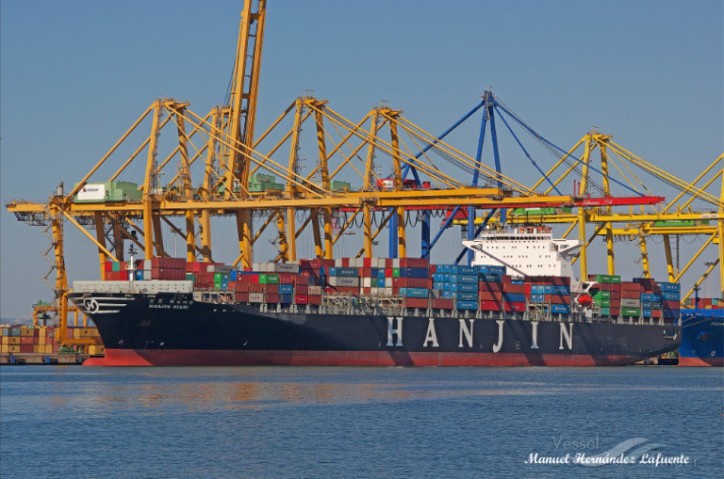After sitting anchored at sea for more than two weeks because of money owed by operator Hanjin Shipping, the Hanjin Miami is expected to enter the Port of New York and New Jersey Thursday.
Maher Terminals told customers Tuesday in an email that unloading of the 7,500-twenty-foot-equivalent-unit ship, which is anchored in the Ambrose Anchorage, about 12 miles offshore, will begin at 8 a.m. Thursday.
The terminal agreed to work the ship after discussions with officials from labor, the terminal, and others involved resulted in the ship paying up front, and the parties came up with a plan to resolve a second problem — the fact that once unloaded, the ship would be too high to get under the Bayonne Bridge. That will be solved by loading containers from other carriers on the ship to weigh it down enough to fit under the bridge, port authority said.
The ship, which set out from Ningbo, stopped at Shanghai before coming through the Panama Canal to Savannah, Wilmington, North Carolina, and New York-New Jersey.

Container ship Hanjin Miami - Image courtesy: Manuel Hernández Lafuente
Maher Terminal, the only one in the port at which Hanjin Shipping vessels stopped, declined to work on the ship after it filed for bankruptcy Aug. 31 in Korea, and it was unclear whether the ocean carrier could pay the terminal, labor and other costs of removing cargo. The Hanjin Miami was one of about 13 Hanjin ships in or near U.S. waters that couldn’t enter U.S. ports, in part because the company could not pay the fees and also — initially — for fear that creditors would seek to seize them.
Several vessels of the stricken company have been arrested in the United States, China, Singapore, Australia, and Canada. A U.S. bankruptcy court on Sept. 6 granted Hanjin Shipping a temporary order of protection, preventing any seizures, and a Korean court has approved the release of some money to unload ships —- including $10 million released on Sept. 9 to provide services for four ships. So far three ships — Hanjin Boston, Hanjin Gdynia and Hanjin Greece — waiting off the ports of Long Beach and Los Angeles have been unloaded. A fourth ship, Hanjin Jungil, remains at anchor in the Pacific.
Two other Hanjin ships are expected to come to the Port of New York and New Jersey eventually. The Hanjin Baltimore has been arrested and is sitting in the Gulf of Panama, and the Hanjin Switzerland is awaiting orders in the Gulf of Suez, after it was unable to pay the fees to pass through the Suez Canal.
Bethann Rooney, assistant director of the port department at the Port Authority of New York and New Jersey, said “Hanjin has paid all port costs upfront after the courts and banks released the money.” Jim McNamara, a spokesperson for the International Longshoremen’s Association, said the union agreed on Friday to work the ship, after discussions between the US Maritime Alliance, which represents employers and carriers, and Hanjin.
John Nardi, president of the New York Shipping Association, said the organization made it clear to Hanjin that the company would have to pay the $89 per container fee that contributes to a worker benefits fund. He said he did not know how much total Hanjin would have to pay, but he added that the company already owes the shipping association about $1.5 million from past fees accrued before the bankruptcy.
“I think everybody will be happy to get this behind us, and get the cargo moving,” he said.
The Miami Hanjin’s problem with the Bayonne Bridge stemmed from the fact that it could pass under the Bayonne Bridge when loaded with full containers, but once its cargo was removed, the empty — and considerably lighter and higher — ship would be too tall to go back under the bridge.
The ship’s situation drew the attention of US Federal Maritime Commissioner William P. Doyle, who said on Sept. 15 at a transportation conference in Indianapolis that “there are so many disputes right now attached to empty containers that the terminal is not going to load the empties back onto the ship.
“If the empties cannot be reloaded on the vessel, then the ship will not be able to depart the harbor because it would not have the air clearance to navigate under the Bayonne Bridge —even at a dead low tide,” he said.
Terminal operators across the country have refused to take empty Hanjin containers, fearing that if they receive the empties and load them onto the ships they won’t get paid, or the empties will sit endlessly on their terminals, causing congestion.
Rooney said the terminal will load empty containers from other carriers to weigh the ship down so that it can go under the bridge.
“It's not unusual to ‘reposition’ empty containers from where they are to where they are needed,” she said.
Source: JOC